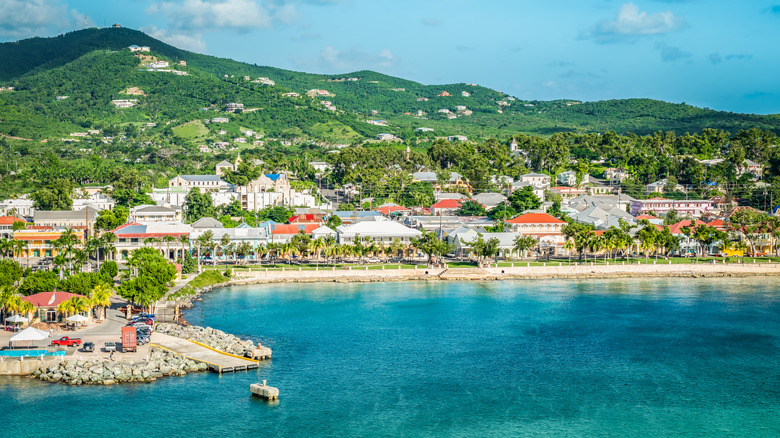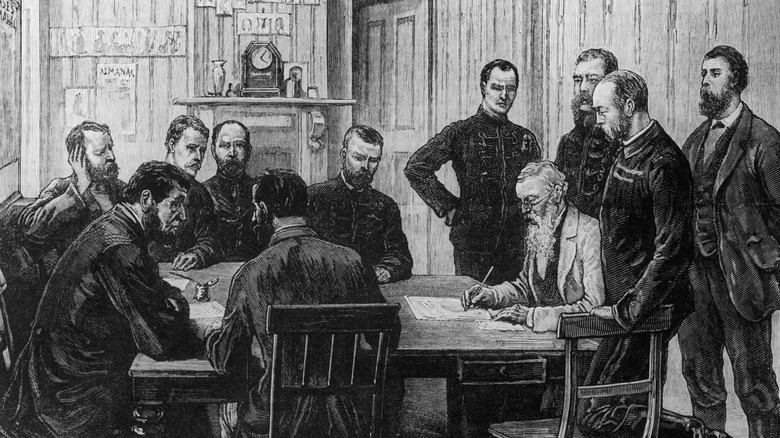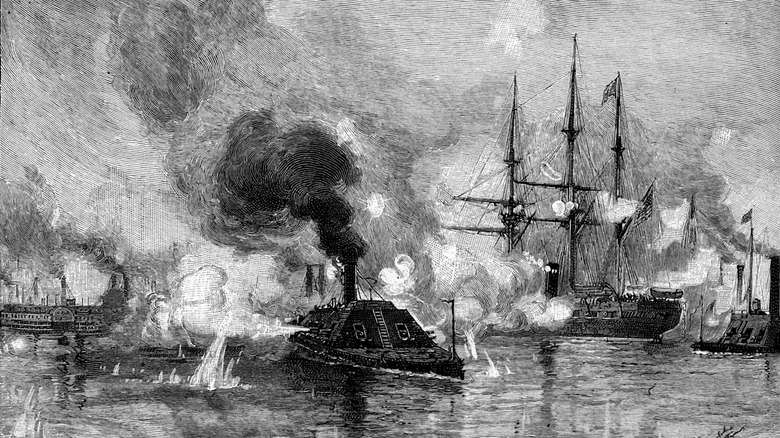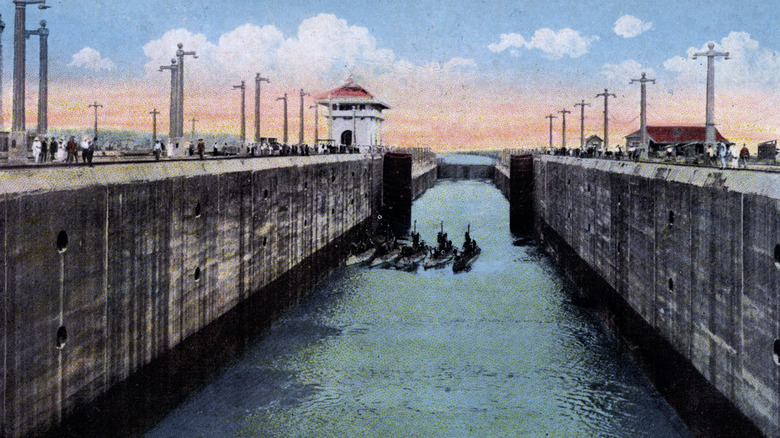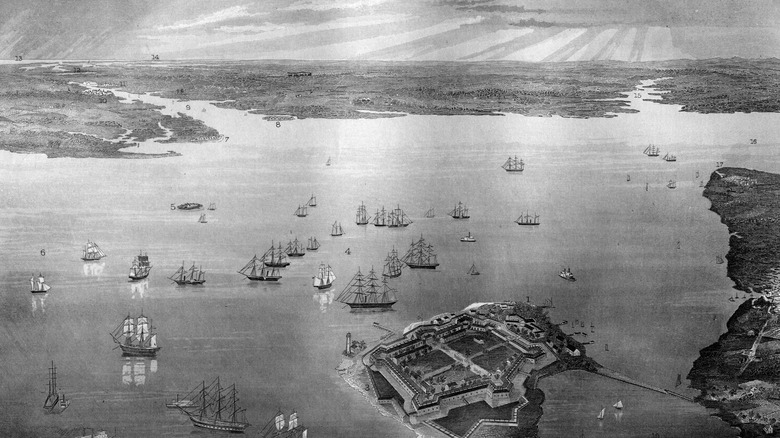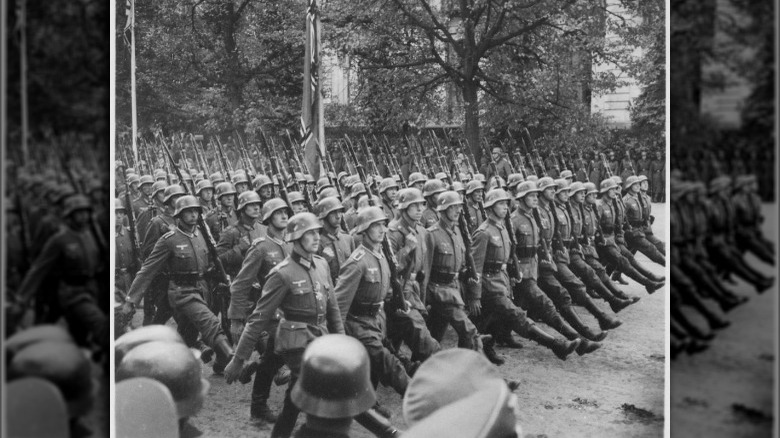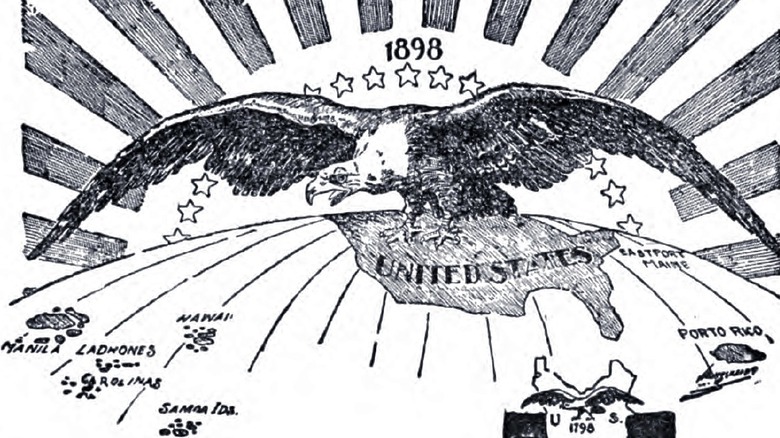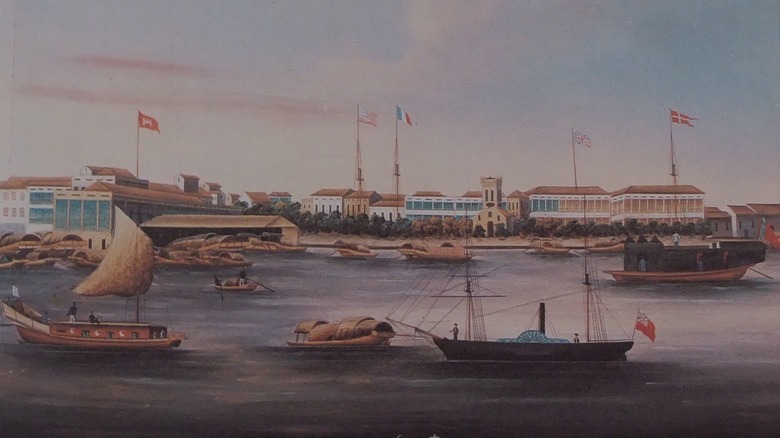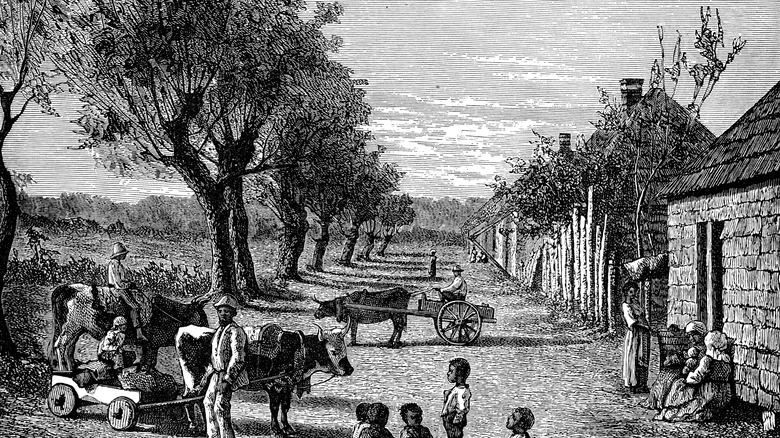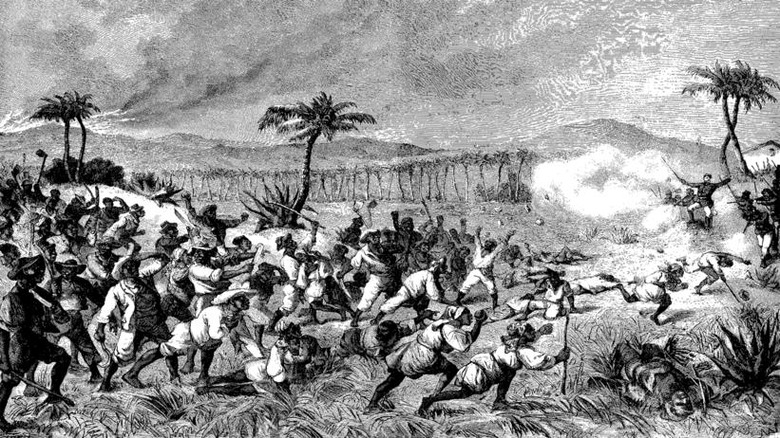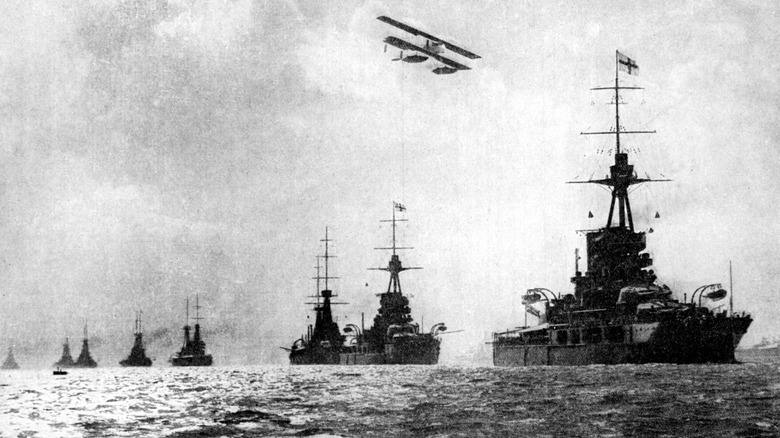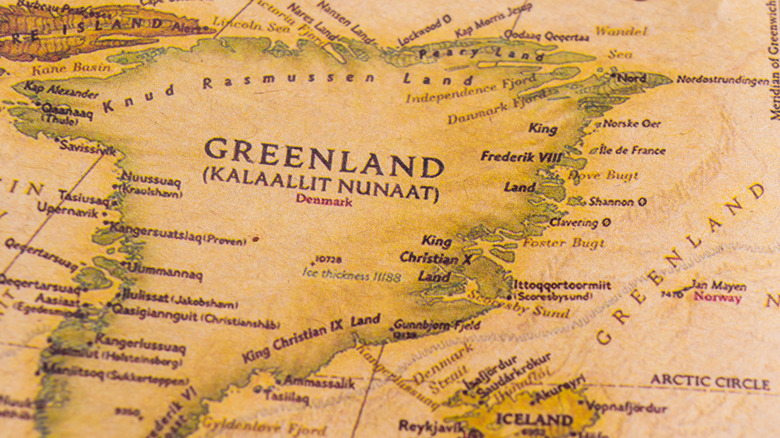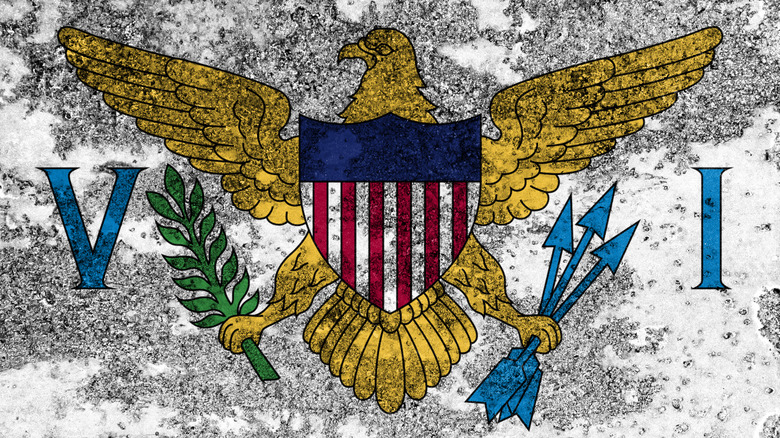The Real Reason Denmark Sold The Virgin Islands To The United States
So, there are some basics to negotiation, right? You know, that whole game of back-and-forth, deciding to compromise or stand firm, adding in stipulations and conditions and all of that stuff. (Or, at the very least, that's definitely what it looks like when you watch it). It seems decently tiring and pretty long under normal circumstances.
Now, what if you took all of that and just raised the scale a little bit? As in, maybe this isn't two people, but two countries, talking about how to handle ownership of entire plots of land. And maybe those negotiations didn't take hours, but multiple decades. Which would mean that the exact reasons and motivations for that trade change and evolve at least a little over time, depending on the situation at large. And could also mean that those reasons include things like global warfare and the potential for imminent destruction.
Well, that escalated quickly, and, to be honest, the "imminent destruction" point is just a little melodramatic. But the rest of it isn't actually fake. It's actually very real and sums up the story of why St. Croix, St. Thomas, and St. John — the Virgin Islands — belong to the United States and not Denmark.
There were long negotiations for the Virgin Islands
Let's get one thing straight here: all of this business with the Virgin Islands wasn't super simple. Sure, some back and forth is what you'd expect of a sale, but when it came to the Virgin Islands — then called the Danish West Indies (via History) — it wasn't just a little negotiation. It was more like 50 years' worth.
U.S. interest in the Virgin Islands first started in the mid-1800s, with negotiations really getting going around 1865. According to the St. John Historical Society, Denmark got back to the U.S. two years later with an offer: they were willing to sell the islands of St. Thomas and St. John for $10 million and would also throw in St. Croix for an extra $5 million. But the U.S. Senate rejected the idea; they had no reason to really buy the islands, and expansion was a touchy topic at the time.
And so the idea was left aside for a while, though some people were still interested. That turned into renewed negotiations in the 1890s, though those talks were interrupted by the Spanish-American War. Still, they did manage to put together a treaty in 1902 which was ratified by the Senate. But that time, it was the Danish Parliament that rejected it.
In the end, the islands were finally signed over on March 31, 1917 for a price of $25 million, a little over 50 years since all of this started.
Interest in the Virgin Islands dates back to at least the Civil War
Even though "An Historical Account of the Purchase and Transfer of the Danish West Indies" says that the interest in the West Indies could've dated back to before the Revolutionary War, the events of the Civil War were really what convinced the U.S. (specifically, the Union) that the islands were important.
Basically, the Union was trying to enforce a blockade on the Confederacy, which could've been an effective way to help bring the war closer to an end, but that just didn't happen. Denmark wasn't the only foreign power that had territories in and around the Caribbean; France and Britain did as well, with Britain being the main problem here. They were unofficially supporting the Confederacy and closed off their ports to the Union fleet. Long story short: the Confederacy was almost able to break the Union blockade because of the location and convenience of those British holdings. Had the islands belonged to the U.S. instead, those problems just wouldn't have existed.
On top of that, though, the conflict between the Union and Britain meant that U.S. dependence on British coal was really on display as a potential problem. That reliance was concerning, but Denmark had been on the side of the Union, leaving their islands open for use as a coaling and supply station. Basically, there was just a lot of potential.
The Virgin Islands were near the Panama Canal
As History explains, the Spanish-American War really changed the status of the U.S. on the world stage. All of a sudden, it was a major imperial power, and so the eye of the U.S. government started turning toward some especially helpful territories.
The Panama Canal was one of those. Granted, there's a lot of history about the Panama Canal and who originally wanted to build it and how it got built, but a really important part was just the fact that it was this dream when it came to international trade (via History). With it, travelling and trading back and forth between the Pacific and Atlantic Oceans were way easier. Of course, the U.S. wanted in on that, and after backing a revolution (again, this is a long story), the U.S. government ended up getting exclusive possession of the Panama Canal in 1903.
The next part of that, though, was how to protect it, and fortunately, the years lined up with when the U.S. was again in talks with Denmark about purchasing the West Indies. As the St. John Historical Society says, the West Indies were perfectly placed to fill that role. Really close to the newly opened Panama Canal, they could prove a convenient strategic asset when it came to defending the Canal.
The economic and strategic benefits of the Virgin Islands
The potential benefits that the U.S. saw to owning the West Indies really weren't anything new. "An Historical Account of the Purchase and Transfer of the Danish West Indies" explains that the economic benefits really have their roots in the pre-Revolutionary War era, with the West Indies having always been a trade partner for the British colonies. Rum and sugar were coming out of the West Indies, and those were products that merchants in the colonies were regularly dealing with. Then, as time went on, trade didn't really stop, with the West Indies becoming more and more tied into American business, so the fact that people were interested in the islands doesn't seem like that much of a surprise.
Then there were the strategic benefits, too, especially as the U.S. expanded its naval power. S.H.G.A.P.E. adds that, even shortly after the Civil War, one of the islands — St. Thomas — proved to be a strategic asset, what with its natural harbor. Really, though, the islands as a whole were ideal for a naval base, and if the U.S. could control that set of islands, then there was access to the entirety of the Caribbean, as well as the Atlantic and Pacific Oceans (because of the Panama Canal). Plus, they could serve as a pretty good base of operations to defend American assets in the area, or even the mainland itself, if things really went south.
The threat of Germany
In all fairness, really, what the U.S. was concerned about was the nearby presence of new foreign powers in the Caribbean. "An Historical Account of the Purchase and Transfer of the Danish West Indies" makes it clear it was just about European powers in general infringing on the American march toward supremacy in the Western Hemisphere. Spanish meddling, for example, also led to some fears about the stability and future of the region.
But still, Germany was the big one when it came to this. Even shortly after a war in 1867, Denmark was already concerned that Germany (then Prussia) and Austria would demand to take the West Indies for themselves. In 1870, rumors again started flying that Germany was in talks with Denmark to purchase the West Indies (via St. John Historical Society); those rumors were unsubstantiated, but still set the U.S. on edge at the prospect of Germany beginning to interfere in the Western Hemisphere.
But things really started ramping up as World War I loomed. There was the distinct possibility that Germany might decide to overrun and take over their neighbor (Denmark). And if that happened, then, potentially, the West Indies would also fall into German hands. According to S.H.G.A.P.E., that was the real concern — that Germany would suddenly have a foothold in the Western Hemisphere right at the doorstep of the U.S., and in the midst of a world war.
The rise of American Imperialism
In the aftermath of the Civil War, American interests weren't actually turned abroad at all. There just wasn't much of a need to start looking to foreign colonies the way European countries had in the past. Really, most people in the U.S. were actually, actively against the idea of expansion, according to History.
But that wasn't meant to last, and maybe that shouldn't be much of a surprise. Manifest Destiny had already been an idea for decades, pushing the U.S. to spread west across North America (via History), and as the late 19th century approached, European countries were, again, focusing their interests abroad, mostly to Africa and Asia (via Texas National Security Review). With this global race for further imperialism heating up, certain leaders in America (notably President Theodore Roosevelt) really pushed for the U.S. to join in and start looking toward overseas expansion.
And, well, that was exactly what happened through the end of the 19th century and the beginning of the 20th. The Spanish-American War, while technically fought over Cuba, ended up bringing a lot more territories into American possession: Guam, Puerto Rico, and the Philippines (via ThoughtCo). Also Hawai'i, in a weird way. Then there was also Alaska, the Midway Islands, American Samoa, and the Panama Canal Zone. America was building its presence on the world stage through this period of rapid expansion and imperialism; the Virgin Islands were just a part of that trend.
The fall of Danish Imperialism
When you think about the big colonial powers, it's probably Britain, Spain, and France that really come to mind as the countries that were putting down roots all over the world. Denmark probably isn't usually in that group, but as Aarhus University explains, they were technically still an imperial power. Maybe not as much as those other countries, but it was still true.
For a few hundred years, Denmark was taking part in trade across the globe, having a hand in trade with India and the surrounding area, as well as in Western Africa, where they established themselves as a pretty major player in the slave trade across the Atlantic. And that's not mentioning their holdings in the Caribbean, along with islands like Greenland and Iceland.
Their colonies had been serving them well through the end of the 18th century, but by the dawn of the 19th century, things started changing. The cession of Norway (which, yes, was once part of Denmark) signaled the beginning of the end, and the now-smaller Denmark just couldn't really handle its colonies anymore. For the next hundred or so years, they sold off those colonies steadily, relieving themselves of economic burdens. The West Indies were just sort of at the tail end of all that, as Danish imperialism and colonialism came to an end.
Economic failings in the Virgin Islands
In the past, the Danish West Indies had been a huge economic asset. Rum and sugar were basically just some really great trade goods, especially when it came to business with the American east coast, to the point that merchants would move to settle in St. Croix (via "An Historical Account of the Purchase and Transfer of the Danish West Indies"). In general, trade was really lucrative.
But things wouldn't stay that way. The loss of Norway meant that holding onto all of these colonies was suddenly even more of an economic burden (via Aarhus University), and that was all on top of the colonies themselves just becoming more expensive to keep running (via History). Eventually, things were bad enough that the islands were running at a deficit; according to S.H.G.A.P.E. the average annual deficit between 1910 and 1917 was about $22,500. And that's a pretty clear problem. Selling the islands to the U.S. ultimately just released that burden from them. It was an economic plus for Denmark.
Extended social unrest in the Virgin Islands
Denmark's colonization of the West Indies ended up leading to the development of plantations (how else would you get enough sugar to sell?). And, maybe unsurprisingly, that also meant that slaves were brought over to work all of those plantations (via History).
That said, the slave trade was abolished in the late 18th century, and a slave revolt in 1848 did theoretically abolish slavery entirely, according to Aarhus University. The thing is, that didn't really matter much in the end. Supposedly, there were new regulations that were meant to be implemented, but that never happened over the course of the next few decades, and nothing actually changed much for the now-freed slaves.
And so tensions persisted for years, boiling over in events like the Fireburn Uprising in 1878. The exact events aren't fully known and there are a few different stories, but by the end of the protest, about a hundred people had died in conflict with the military, and a city had been set on fire, half of it burning down entirely. Even more people were given the death penalty in the aftermath, but things still weren't great. Wages went up a little, but the human rights issues still went unsolved. By the time the workers began forming unions, Denmark just ended up selling the islands to the U.S. instead.
The U.S. forced Denmark's hand
With the coming of World War I, there's this particular narrative about how the U.S. might've gotten their hands on the Virgin Islands. History tells it in the context that Germany was a huge threat to the U.S. The possibility of Denmark (and, by extension, the West Indies) falling into German hands was unacceptable.
At the time (around 1915), Denmark actually wasn't planning to hand over the islands, so the U.S. switched to a new tactic. Bullying, essentially. Threats to the tune of just taking the islands from Denmark by force, just to make sure the Germans couldn't get to them first. Unsurprisingly, that got Denmark's attention and forced their hand. Being neutral in World War I, Denmark didn't want to start provoking any further attacks, and so they did decide to negotiate a treaty with the U.S. (which was also still neutral at that point), selling the islands for $25 million.
That said, though, it might not have been entirely antagonistic, exactly. The Danish West-Indies mentions secret telegrams regarding the negotiations for the islands, in which the Danish Minister of Foreign Affairs states that selling to the U.S. was actually a pretty preferable outcome, all things considered. Things weren't really all that bad, maybe.
Denmark was interested in Greenland
If you go through the treaty for the cession of the Danish West Indies, most of it is pretty much what you'd expect. But there's this one little part at the end: "...the United States of America will not object to the Danish Government extending their political and economic interests to the whole of Greenland."
And that just sounds sort of out of left field. Why is Greenland coming up in this treaty about the West Indies? Well, according to Charles Emmerson's "The Future History of the Arctic," Denmark had been interested in extending their influence over Greenland ever since it was transferred to them in 1814. The problem, though, was that ownership of Greenland was easily disputed. It'd been passed from Norway to Denmark when Norway itself had been transferred to Sweden from Denmark. And then to make things more complicated, the U.S. kind of had a claim to part of Greenland, which had been occupied by an American explorer in the 1870s. Denmark just really wanted Greenland, and adding that stipulation to the treaty helped them along that goal. It took the U.S. out of that particular picture.
Looking forward, according to Aarhus University, Greenland is really the only colony Denmark never let go of, and throughout the 20th century, they were willing to jump through a bunch of legal hoops just to hold onto it, including, but not limited to, later Norwegian claims to the land.
The Virgin Islands were still kind of a mess
The sale of the Danish West Indies and their renaming to the U.S. Virgin Islands, for all the benefits it seemed to have Denmark and America, didn't really end up solving all that many problems. At least, when it came to the residents of the islands themselves.
For one, Denmark was actually hesitant to sell their islands to the U.S. around 1915 (via History). After all, a lot of the population of the then-West Indies was Black, and the U.S. was still really heavily segregated, something that still wouldn't change for decades. And that proved to be a decent reason for concern, S.H.G.A.P.E. mentioning that racism played a part in the fact that, for most of the residents of the Virgin Islands, nothing changed. The U.S. just used the islands as a naval base, but sort of forgot about them otherwise, never really paying them much mind and seeing them as a colonial backwater.
Legally, things weren't a lot better. The treaty left a lot of loose ends, and it left the future unclear for people living on the islands. They weren't actually American citizens, though they were considered, technically, of American nationality. Citizenship wouldn't come for another 15 years, and voting wouldn't be a thing for another 40 years on top of that.
There are some positives, to be fair. A growing tourism industry and more self-government, for example. At least it's something?
